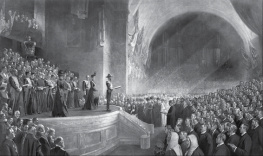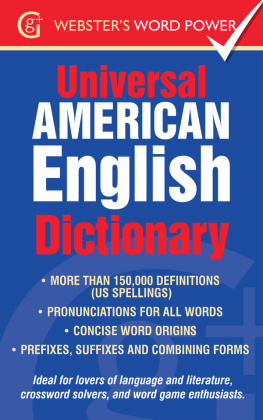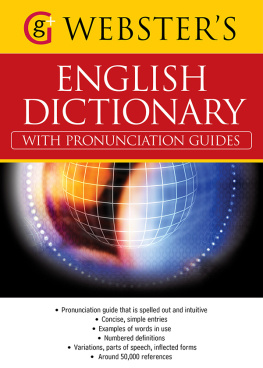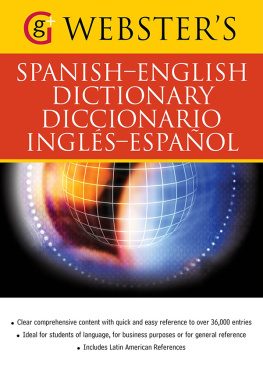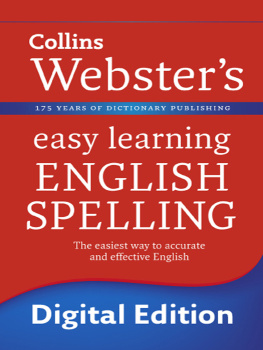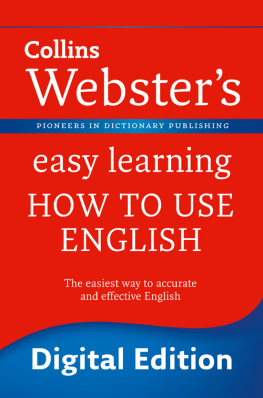PICTORIAL
WEBSTERS
A Visual Dictionary of Curiosities
WITH ADDITIONAL DISSERTATION BY
JOHN M. CARRERA
AUTHOR, COMPOSER, PRINTER

Text copyright 2009 by John M. Carrera
Original edition of Pictorial Websters 2007 by John M. Carrera

The images Foundation, Jumper, Grammy, and Six-Pack: used by permission.
From Websters Third New International Dictionary, Unabridged 1993 by
Merriam-Webster Inc. ( www.Merriam-Webster.com ).
All rights reserved. No part of this book may be reproduced in any form without
written permission from the publisher.
ISBN: 978-1-4521-0083-8
The Library of Congress has previously cataloged this title under ISBN
978-0-8118-6718-4
Cover Design and Typesetting by Eloise Leigh
Chronicle Books LLC
Second Street
San Francisco, CA 94107
www.chroniclebooks.com

NOAH WEBSTER
17581843
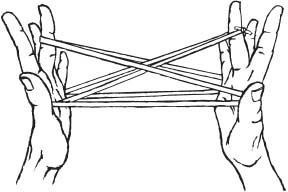
19501999
for SAM WALKER
KEY TO THE NUMBERS AND LETTERS ACCOMPANYING THE ENGRAVINGS
The numbers accompanying the images were stamped on the side of each engraving by G. & C. Merriam Co. as an indexing system. The notation following the index number, added for this project, tells more about each engraving:
W denotes images printed directly from wood engraving blocks.
M denotes images printed from metal electrotypes.
D denotes images digitally captured and added for this trade edition.
The following letters and numbers are used to indicate the first edition of the dictionary in which the image appears:
I denotes engravings copied from an image found in the Imperial Dictionary of 1851 .
denotes the 1859 American Dictionary of the English Language (the first illustrated dictionary printed in the United States).
denotes the much larger 1864 edition.
N denotes the 1890 International Dictionary.
L denotes an edition printed after 1900 .
E denotes the 1909 Second International Dictionary.
(Note that there were many updated versions of each edition; some of these engravings may have been recut duplicates or updated images.)
PREFACE
In the summer of 1995 , while poking around my grandmothers stone farmhouse, I found a tattered 1898 Websters International Dictionary under my grandfathers favorite reading chair. The disintegrating sheepskin covers were detached and a number of browned and brittle sections were falling out from the back of the book. The loose pages revealed an eighty-page section devoted entirely to the illustrations of the dictionary: a stunning array of odd and wonderful animals and machines printed by categories. The fantastic variety of subjects was matched only by the detail and variety of engraving techniques.
Shortly before discovering that fateful Websters, I had completed a collaborative artists book for an exhibit at the Dibner Library at the Smithsonian Institution that grappled with questions of the origin of ideas. I realized a book filled with disparate images, such as those from the Websters, could be an artistic experiment to test my hypothesis on the origin of creativity: that new ideas arise from the recombinations of old ideas. It would also be an important and beautiful visual reference. That fall I contacted the Merriam-Webster Company and discovered that the engravings still existed. They had been given to Yale University in 1977 . This book is the culmination of a long odyssey to put the engravings back into print and make a book designed to educate, inspire, and entertain.
Nearly all the engravings in this work are culled from the nineteenth-century engravings used in Websters dictionaries printed by the G. & C. Merriam Co. (George and Charles Merriam bought the rights to the official Websters after Noah Websters death in 1847 .) More than 10,000 engravings and their exact duplicates, called electrotypes, now reside in the Press Room of the Arts of the Book Collection at Yale University. The engravings, or cuts, are stored in a long row of dark-green cabinets housing more than cases (drawers) filled to the brim. My first, thrilling look at one of these drawers revealed hundreds upon hundreds of dust-covered cuts strewn in an unintelligible jumble. At that moment I grasped the vastness of the collection, but I still had no idea I was about to devote more than a decade of my life to this endeavor.
It took a year to simply identify and alphabetize the engravings I selected for Pictorial Websters . After showing my commitment by reorganizing the collection, the Sterling Library made a unique loan agreement allowing me to borrow the engravings and print an artists book with the original cuts at my Quercus Press. It was a tedious, laborious process preparing and printing the century-old cuts by hand, but seeing the old blocks brought back to life as crisp images on good paper kept the project going month by slow month as the years ticked by. The fine press edition of Pictorial Websters was printed using a letterpress, the same relief process that was used to print the original dictionaries.
In letterpress printing, ink is rolled onto the letterforms made of metal type and the engravings, which are then printed directly onto the paper. The printed image is the reverse image of the type and engravings, and the engraved blocks are the same size as the images they print. Because they wanted to fit as many words and images in the dictionaries of the late nineteenth century as possible, the images had to be small. Most of the blocks in the fine press edition are smaller than an inch square. Some of the engravings are so small in the original that one needs magnification to appreciate the delicate lines and skill that went into their making. Many of the engravings created for the 1890 International Dictionary (such as Aurochs on ) were executed with too much detail for the printing process and paper used, so appear as black silhouettes. But by using a sophisticated reproduction letterpress of the twentieth century, printing on smooth paper from the original blocks, I was able to bring out the best detail of every line of these intricately carved images.
When I began working on Pictorial Websters in 1996 , it was always with the plan to entice a publisher to bring the work to a wider audience. For this reason I made master proofs of each print run on ultrasmooth paper to make as faithful a reproduction of the engravings as possible. I am thrilled that this book is being published by Chronicle Books, as Chronicle has been a great innovator in using the full possibilities of trade production methods to create unique and original books. As the book is mostly visual and conceptual, it can be mass produced without losing the essential quality of the work.
Since I started this project, reproduction technology has changed completely. One of the improvements in this edition is that the images have been enlarged to a modest percent so readers can better appreciate the engravings themselves. By using the magic of the computer, this edition further restores the original lines intended by the engravers, while keeping the quality of tone that letterpress printing imparts. Digital technology has also allowed this edition to continue to explore and play with the content of the book. In this way this book is not merely a copy of the fine press edition, but has become its own unique version that may even surpass the other in some aspects.



